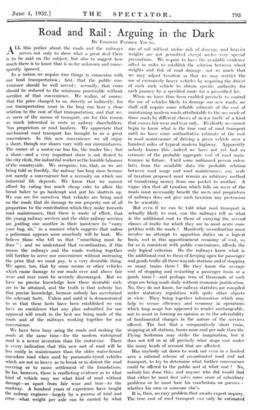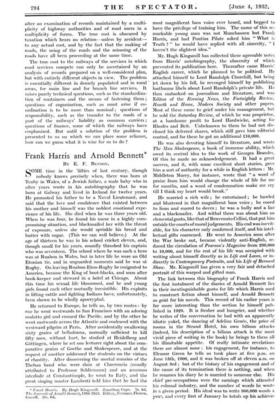Road and Rail : Arguing in the Dark
By COLONEL PATRICK YOUNG.
ALL this pother about the roads and the railways serves not only to show what a great deal there is to be said on the subject, but also to suggest how much there is to know that is so far unknown and conse- quently ignored.
As a nation we require two things in connexion with our land transportation ; first, that the public con- venience should be well served ; secondly, that costs should be reduced to the minimum practicable without sacrifice of that convenience. We realize, of course, that the price charged to us, directly or 'indirectly, for our transportation must in the long run bear a close relation to the cost of that transportation, and that we, as users of the means of transport, are for this reason as much interested in costs as railway shareholders, 'bus proprietors or road hauliers. We appreciate that mechanical road transport has brought to us a great convenience. In this new convenience we all enjoy a share, though our shares vary with our circumstances. The owner of a motor-car has his, the trader his ; but a share—and a very important share is not denied to the city clerk, the industrial worker or the humble labourer of the countryside. We recognize, too, that, as we arc being told so forcibly, the railway has long since become not merely a convenience but a necessity on which our industrial life depends. We know that we cannot afford by eating too much cheap cake to allow the bread baker to go bankrupt and put his shutters up. We can see for ourselves that vehicles are being used on the roads that do damage to our property out of all proportion to the contribution which they make towards road maintenance, that there is waste of effort, that the young railway services and the older railway services are jostling one another in their insistence to "carry your bag, sir," in a manner which suggests that unless a policeman appears soon somebody will be hurt. We believe those who tell us that "something must be done " ; and we understand that co-ordination, if this means the railways and the roads working together still further to serve our convenience without increasing the price that we must pay, is a very desirable thing. We agree, too, that by some means or other vehicles which cause damage to our roads over and above fair wear and tear must be severely discouraged. But we have no precise knowledge how these desirable ends are to be attained, and the truth is that nobody has that precise knowledge, because nobody has ascertained the relevant facts. Unless and until it is demonstrated to us that these facts have been established we can have no confidence that any plan submitted for our approval will result in the best use being made of the roads and of the railways working together for our convenience.
We have been busy using the roads and making the roads at the same time—for the modern waterproof road is a newer invention than the motor-car. There is every indication that this new sort of road will be less costly in maintenance than the older water-bound macadam road when used by pneumatie-tyred vehicles which are not so heavy as to break or to distort the road covering or to cause settlement of the foundations. So far, however, there is conflicting evidence as to what kind of vehicle may use what kind of road without damage—as apart from fair wear and tear—to the roadway. A hundred years of experience have taught the railway engineer—largely by a process of trial and error—what weight per axle can be carried by what size of rail without undue risk of damage, and heavier weights are not permitted except under very special precautions. We require to have the available evidence sifted in order to establish the relation between wheel weights and risk of road damage—not so much that we may adjust taxation as that we may restrict the use of excessively heavy vehicles by requiring the driver of each such vehicle to obtain specifie authority for each journey by a specified route for a prescribed fee.
When we have thus been enabled precisely to control the use of vehicles likely to damage our new roads, we shall still require sonic reliable estimate of the cost of maintaining modern roads attributable to the use made of those roads by different classes of motor trafliti of is kind that causes fair wear and tear only. Evidently we cannot begin to know what is the true cost of road transport until we have some authoritative estimate of the cost in road maintenance of driving a given vehicle over a hundred miles of typical modern highway. Apparently nobody knows this—indeed we have not yet had an estimate of the probable aggregate cost of road main- tenance in future. Until some unbinssed person calcu- lates from the available data the probable relation between road usage and road maintenance, any scale of taxation proposed must remain an arbitrary method of transferring money from one pocket to another. A
vague idea that all taxation which falls on users of the roads must necessarily benefit the users and proprietors. of railways does not give such taxation any pretension to be scientific.
But even if we can be told what road transport is actually likely to cost, can the railways tell us what is the additional cost to them of carrying the several classes of traffic for which they are in most acute com- petition with the roads ? Manifestly co-ordination must involve an attempt to apportion duties on a logical basis, and in this apportionment economy of cost, so far as is consistent with public convenience, affords the only logical criterion. Do the railways know what is the additional cost to them of keeping open for passenger and goods traffic all those wayside stations and of stopping so many trains there ? Do they know the average cost of stopping and restarting a passenger train or a goods train ?—and perhaps tens of thousands of such stops arc being made daily without economic justification.
No, they do not know, for railway statistics are compiled under statutory regulation with quite other objects in view. They bring together information which may help to secure efficiency and economy in operations which long usage has appeared to render unchangeable,
not to assist in forming an opinion as to the advisability of fundamental changes in the nature of the services offered. The fact that a comparatively short train, stopping at all stations, burns more coal per mile than the Flying Scotsman may strike the imagination, but it does not tell us at all precisely what stops cost under the many heads of account that are affected.
Has anybody sat down to work out even in a limited area a rational scheme of co-ordinated road and rail transport, to try to determine what further convenience could be offered to the public and at what cost ? No, nobody has done this; and anyone who did would find that either he must first solve some score of subsidiary problems or he must base his conclusions on guesses whether his own or someone else's.
It is, then, no easy problem that awaits expert inquiry. The true cost of road transport can only be estimated
after an examination of records maintained by a multi- plicity of highway authorities and of road users in a multiplicity of forms. The true cost is obscured by taxation which bears no relation—unless by accident— to any actual cost, and by the fact that the making of roads, the using of the roads and the misusing of the roads have all been proceeding at the same time.
The true cost to the railways of the services in which road services compete can only be ascertained by" an analysis of records prepaied on a well-considered plan, but with entirely different objects in view. The problem is essentially different in densely populated and in rural areas, for main line and for branch line services. It raises purely technical questions, such as the standardiza- tion of containers and the means of fastening them questions of organization, such as must arise if co- ordination is to be more than nominal ; questions of responsibility, such as the transfer to the roads of a part of the railways' liability as common carriers ; questions of finance, some of which the railways have emphasized. But until a solution of the problem is presented to us on which we can place some reliance, how can we guess what it is wise for us to do ?





































 Previous page
Previous page